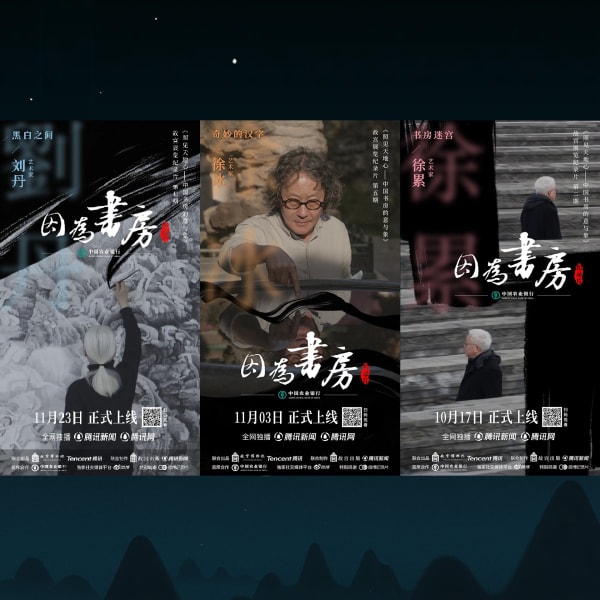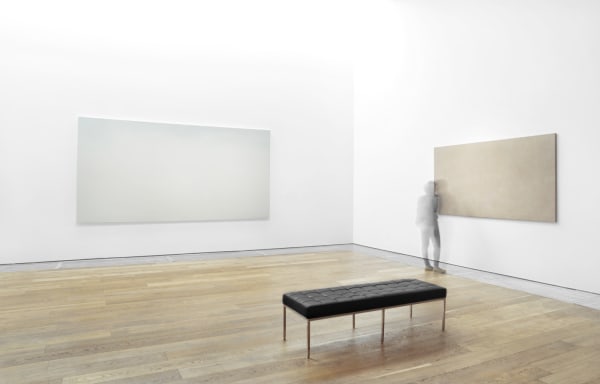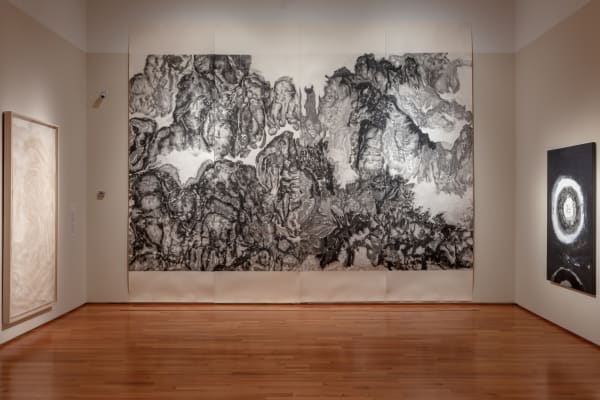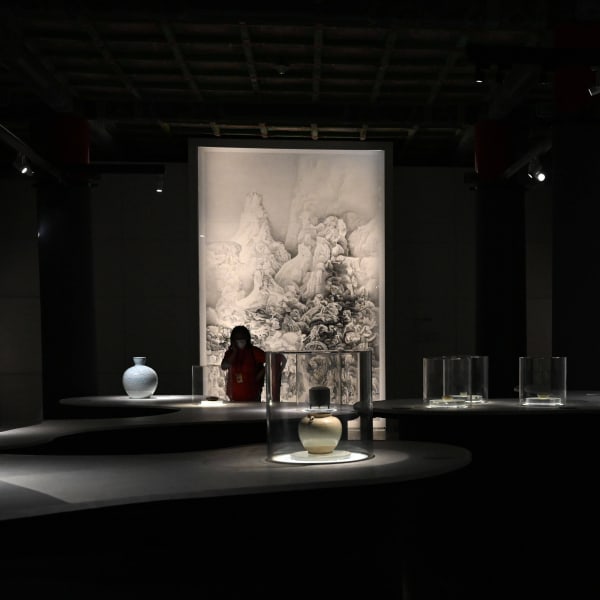Liu Dan (b. 1953) was one of the first Chinese artists to emigrate to the United States in 1981 and beginning in the 1990’s the foremost proponent of neo-Song, photo-realism in contemporary Chinese painting. Whether landscapes, scholar’s rocks, or old cypress trees in the Forbidden City, all of Liu Dan’s creations emerge out of a deep aesthetic engagement with the past, reflection on metaphysical questions related to ontology and cosmogony, a focus on compositional structure and movement through meticulous, preparatory draughtsman-ship in a mode not unlike old-master drawing, and the performative execution of the final work using traditional Chinese brush techniques and materials. Liu Dan sees his almost photorealistic depictions of natural forms as moments or “folds” in a nature’s dynamic unfolding of material reality. Realism, thus deployed, is not a mode of depicting material objects but rather—through a deep aesthetic engagement with the artistic past and a corresponding experiential engagement with the natural present—depicting both the material and metaphysical process of forming. Along with Xu Bing, Cai Guoqiang and Zheng Chongbin, Liu Dan is one of the few contemporary Chinese artists to successfully bridge diachronic and encyclopedic institutions such as the Metropolitan Museum, the British Museum and LACMA with contemporary and modern art institutions such as the Centre Pompidou and the Guggenheim Museum.
Born in Nanjing, Jiangsu, in 1953, Liu Dan has emerged as one of the most gifted of a particularly talented generation. He studied the Confucian classics, poetry, painting, and calligraphy with his grandfather at an early age. After the Cultural Revolution, Liu studied traditional painting under Ya Ming (1924–2002) at the newly reopened Jiangsu Academy of Chinese Painting, Hangzhou, from 1978 to 1981. In 1981, the U.S. Embassy arrange for Liu and his American fiancée to leave China and settle in Hawaii where they married. There, he studied Western Art and developed his distinctive synthesis of photo-realism, classical Chinese painting, and metaphysics. Liu Dan moved to New York in 1992 where he met Ai Weiwei, Xu Bing and other prominent expatriate artists from China. Unlike his newly arrived compatriots, Liu Dan eschewed mass culture, conceptualism, and political activism, and chose instead to research further the methodological and metaphysical foundations for his distinctive syncretic practice. After fourteen years he returned to China in 2006 to begin mentoring a younger generation of artists interested in engaging with China’s indigenous artistic heritage.
Beginning in 1980s, Liu became intrigued by rocks. To him, “rocks are the stem cells of nature, a symbolic microcosm of the material world.” Traditionally Chinese scholars and artist utilized rocks as models of mountains in their urban gardens, in their landscape paintings and in their deployment of poetic and philosophical metaphor. Through the meticulous study of a single rock, Liu attempts to see the macroscopic universe from a particular microscopic vantage. He transforms a tangible object into an aesthetic meditation on the nature of form and of forming. His aspiration is for his audience to use the rocks he paints as an aesthetic key to renew their imaginative engagement with the world.
Liu Dan’s work was featured in Art and China after 1989: Theater of the World at the Guggenheim Museum (2017-2018) and in 2019, his work will be exhibited as part of the Centre Pompidou’s ongoing exploration of non-Western modernities following upon its 2014 exhibition Modernités Pluriélles. His work was also featured prominently in Ink Art: Past as Present in Contemporary China at the Metropolitan Museum (2014) and in major group shows as the China Institute Gallery in New York (2006, 2014), the British Museum in London (2012), the Musée Guimét in Paris (2012), the Museum of Fine Arts, Boston (2011), the Princeton University Art Museum (2009), the Israel Museum in Jerusalem (2008), the Louisiana Museum of Art in Denmark (2007), the Arthur M. Sackler Museum, Harvard University (2006), the 6th Shanghai Biennale (2006), the Museum of Contemporary Art Shanghai (2004), the Art Institute of Chicago (1999), and the Yale University Art Gallery (1999).
Liu Dan has also had major solo museum exhibitions at the Minneapolis Institute of Art (2016), the Ashmolean Museum at Oxford University (2016), and the Suzhou Museum (2013), the Museum für Ostasiatische Kunst in Berlin (2005), and the San Diego Museum of Art (1999), the Contemporary Museum in Honolulu (1993) and the Honolulu Academy of Arts 1989).
-

Global INK: INKstudio’s Ten Year Anniversary Exhibition
Bingyi, Chen Haiyan, Huang Chih-yang, Li Jin, Li Huasheng, Liu Dan, Peng Kang-long, Wang Dongling, Wang Tiande, Xu Bing, Yang Jiechang, Zheng Chongbin 17 Jun - 29 Jul 2023The current exhibition, Global INK, is our opportunity to share with everyone what we have discovered over our first decade of programming. It is not a group show but instead a special exhibition consisting of twelve separate solo presentations by twelve artists who we believe define the new global contemporary INK.Read more -

Four Accomplishments in Ink
Liu Dan | Master of the Water, Pine and Stone Retreat | Xu Lei | Zeng Xiaojun 13 - 29 Mar 2019Beijing-based gallery INKstudio marks its debut in the official program of Asia Week New York with a selection “Four Accomplishments in Ink”—a gathering of four great ink artists who are themselves noted connoisseurs and collectors of art.Read more -

Ink and the Mind
Ink and phenomenology. Exhibition No.2 19 Mar - 12 May 2016Ink and the Mind explores the myriad connections between ink painting and cognition, perception, affect, and imagination.Read more
-
Exhibition | Summoning Memories: Art Beyond Chinese Traditions, Asia Society Texas Center
Bingyi, Jennifer MA Wen, Liu Dan, Tao Aimin, Wang Tiande, Xu Bing, Zheng Chongbin May 10, 2023Summoning Memories: Art Beyond Chinese Traditions Date: 10 February - 2 July 2023 Venue: Asia Society Texas Center, Houston, Texas, US Curated by Susan L....Read more -

Documentary | Liu Dan, Mirroring the Heart of Heaven and Earth—Ideals and Images in the Chinese Study
December 3, 2022On November 23, Between Black and White, a film featuring the artist Liu Dan was officially screened on Tencent, as part of the documentary series...Read more -

Exhibition | Liu Dan, Xu Bin & Xu Lei at The Palace Museum, Beijing
Mirroring the Heart of Heaven and Earth—Ideals and Images in the Chinese Study November 16, 2022Mirroring the Heart of Heaven and Earth—Ideals and Images in the Chinese Study 2022, 08.30-2022, 11.30 Meridian Gate ( Wu men), Palace Museum Watching the...Read more -

Exhibition | Bingyi, Liu Dan at "Ink/stone", Fairfield University Art Museum
April 9, 2022Ink/stone January 21 - March 5, 2022 virtual presentation still on view Fairfield University Art Museum Walsh Gallery At the time of growing academic interest...Read more
-

Because of the Study 因为书房
Documentary of the exhibition "Mirroring the Heart of Heaven and Earth—Ideals and Images in the Chinese Study" December 3, 2022Because of the Study was jointly produced by the Palace Museum and Tencent on the exhibition of Mirroring the Heart of Heaven and Earth—Ideals and...Read more -

Bingyi, He Yunchang, and Nataline Colonnello on CCTV News
February 15, 2017INK studio Director Nataline Colonnello and artist Bingyi discuss contemporary Chinese art in the March 12, 2016 episode of the CCTV News program 'Crossover.' He...Read more -

The Enduring Passion for Ink: A Project on Contemporary Ink Painters
Britta Erickson February 7, 2017The Enduring Passion for Ink: A Project on Contemporary Ink Painters (or the 'Project') is a proposed exhibition, book, and film series designed to introduce...Read more








